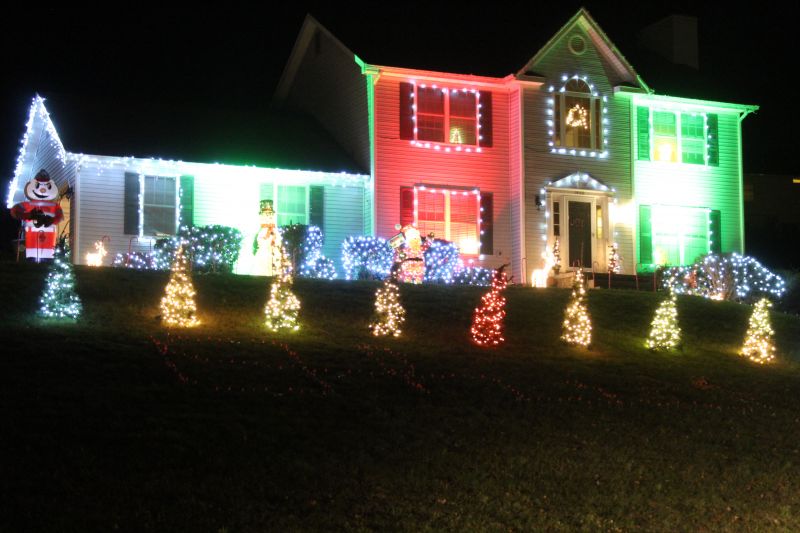
Jeff Gandee’s light display at 1460 Sleepy Hollow Road in Christiansburg is accompanied with holiday music that can be heard at 89.7 on your car radio.
By Marty Gordon
Jeff Gandee has always loved the 1989 movie National Lampoon’s Christmas Vacation, starring Chevy Chase. So much so, the Christiansburg man has made it his mission to attempt to copy the number of lights on his home.
“I love the movie and just thought it would be cool to light up my home and the neighborhood so to speak, but I will never be able to conquer Clark’s effort,” he said earlier this week when he flipped the switch on his annual display.
Christmas Vacation has often been labeled a modern Christmas classic, and Clark Griswold (Chevy Chase’s character in the movie) covers the house’s entire exterior with 25,000 twinkling lights. When turned on, the display causes a temporary citywide power shortage.
So, for the past eight years, Gandee has kept up the tradition. He estimates there are between 7,500 and 9,000 lights on and around his home.
A home in LaGrangeville, N.Y., lays claim to the Guinness World Record with 601,736 lights set to more than 200 songs. Today, it is estimated that more than 150 million light sets are sold in America each year with more than 80 million homes decorated with holiday lights.
The idea of putting up colored lights days and weeks before Christmas day dates to the 1940s and 1950s when people decorated their homes to symbolize the Christmas star that was supposed to have led the Three Wise Men to the manger where Jesus was born.
But the lighting efforts can use up a lot of kilowatts. Estimates show American household Christmas lights use up more electricity over the holiday season than some poorer countries—such as El Salvador or Ethiopia—do in a year.
Bright lights strung on American trees, rooftops and lawns account for 6.63 billion kilowatt hours of electricity consumption every year, according to a recent blog post by the Center for Global Development.
El Salvador for one, uses 5.35 billion kilowatt hours, while Ethiopia consumes 5.30 billion and Tanzania 4.81 billion per year.
Researchers Todd Moss and Priscilla Agyapong used data from a 2008 US Department of Energy report and the World Bank.
Gandee said his display uses very little electricity since he has changed everything over to LEDs.
Six years ago, he added a radio transmitter to allow for music to be played. “Before then, we had music piped through speakers in the yard. Neighbors started to hate that, so I added the transmitter,” Gandee said.
A computer runs the songs and lights that seem to magically be timed together.
Gandee admits he is always open to spending more money on lights despite the displeasure of his wife, Lisa.
“I tend to add more each year, and this time, I have added Brutus (Ohio State mascot), the Hokie Bird and something recognizing James Madison University, where my son goes to school,” he said.
While cars drive by the house constantly during the holiday season leading up to Christmas, the best view seems to be several blocks away leading to the home. “I really don’t know where the best view is, but I have been told it’s as you drive toward the display,” Gandee said.
He has no estimate of how many people have seen his display. Occasionally, he steps to the front of the lawn and hands out candy canes. “I enjoy seeing and hearing that other people have enjoyed it,” he said, “and that’s why I keep doing it.”
Two years ago, he received a Christmas card saying an anonymous donor had made a contribution to Habitat for Humanity in his name because of the joy received from his light display.
The card read: “Thanks for the holiday lights and the candy when we stopped by last year.”
Gandee’s display at 1460 Sleepy Hollow Road in Christiansburg is accompanied by at least 11 different holiday tunes and can be dialed in at 89.7 on your car’s radio.
The homeowner just hopes he adds a smile to someone’s face this Christmas season.
Please let the newspaper know where there are other great light displays, and who knows, we might just swing by and take a photograph of it to share.


